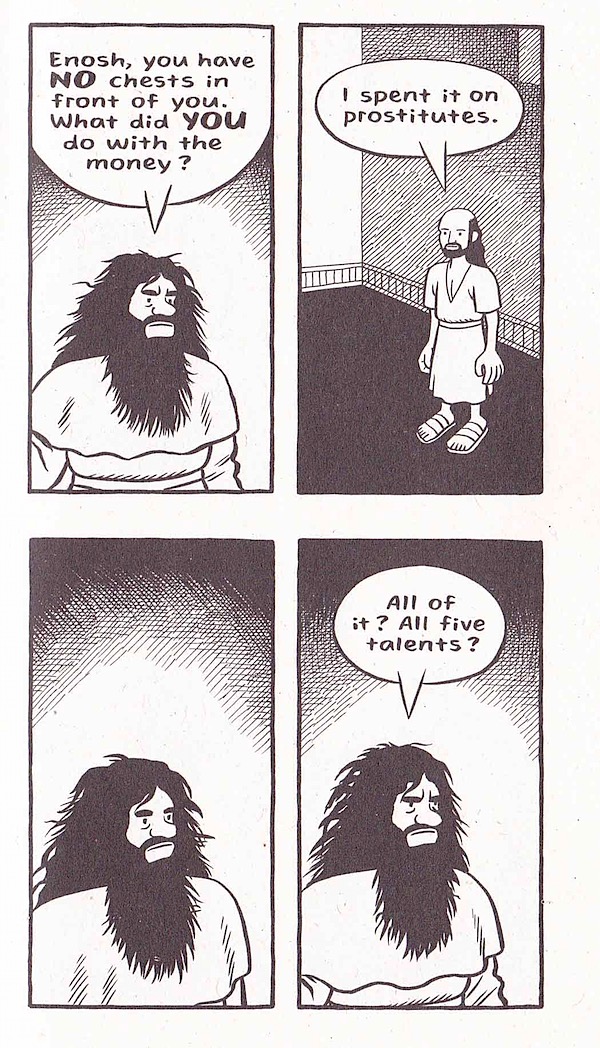Regular Beat readers know I’m OBSESSED with Chester Brown’s Mary Wept Over The Feet of Jesus. For many years, I’ve generally admired Brown’s work, from the gonzo Ed the Happy Clown to the devastating I Never Liked You to the eerie Louis Riel. Well, Mary Wept is gonzo, devastating AND eerie! It also has some of the most head scratching Bible scholarship of comics history. I pondered how Brown came up with some of his interpretations, because…well, here’s a little confession, when I was a kid I read the Bible and some biblical scholarship, and even based on my patchy memory, Brown omits a lot of things and switches around others in a fairly selective way. And I wasn’t sure why, but finally we have the money shot!
But it’s a little long, so bear with me. As you may recall, in his last book, Paying for It, Brown expressed his enthusiasm for prostitution as a substitute for ultimately fruitless romantic relationships, and he’s been an advocate for decriminalizing and normalizing prostitution as a profession. With that background, Mary Wept interprets several Bible stories as signaling a secret approval of prostitution.
As I mentioned in a report on a reading by Brown the other night, one of the centerpieces of the book is a reworking of the Parable of the Three Talents from the Gospels. A talent is a measure of money and in the Bible the story goes kinda like this: A rich man goes away for a couple of years and gives three slaves a talent or so each for safe keeping. Two of them invest it, and one is afraid he’ll lose it so he buries it. When the master comes back he rewards the two who invested and fires the guy who left it in a hole in the ground.
Okay now BROWN’S VERSION: Chester quite rightly intuits that most stories about three thing have THREE DIFFERENT THINGS, not two guys doing the same thing. How shall we learn otherwise? So in his story, which is based on a supposed older original version, one slave invests the money, one buries the money, and the third just spends it ALL on whores.
When the master comes back, he’s mad at the investor and the burier, but the guy who spent the money having a good time is the best slave of all!Because…because prostitution is good, I guess. But where is this text that Brown used for his version?
NOW, enter critic Ng Suat Tong, who has a lengthy piece analyzing the book and pointing out the actual sources of some of Brown’s interpretations:
From Bart Ehrman and Zlatko Plese’s translation of Eusebius’ paraphrase of “The Parable of the Talents” in Theophania: “For the Gospel that has come down to us in Hebrew letters makes the threat not against the one who hid the (master’s) money but against the one who engaged in riotous living. For (the master) had three slaves, one who used up his fortune with whores and flute players, one who invested the money and increased its value, and one who hid the money. The one was welcomed with open arms, the other blamed, and only the third locked up in prison.” [emphasis mine] In his quotation of Ehrman in his notes, Brown deliberately leaves out the first section of Eusebius’ summary—that it was the servant who “engaged in riotous living” (i.e. the one who used up his fortune with whores and flute players) that was cast into the outer darkness with the concomitant weeping and gnashing of teeth.
OK. That seems like a direct contradiction. And now the exciting confrontation because Brown shows up in the comments!!! And explains why he left out that sentence where the master gets salty with the whoring slave:
Your interpretation of The Omitted Passage is that it’s saying that the master punishes the whoremonger-slave and rewards the-slave-who-hid-the-money. But take another look at The Omitted Passage. It actually does not say that the master “makes the threat” against the whoremonger, it says that The Gospel Of The Nazareans makes the threat.
Tong comes right back with this:
“…the Gospel that has come down to us in Hebrew letters makes the threat not against the one who hid the (master’s) money but against the one who engaged in riotous living.”
Since Eusebius is our only source (at present) for the Nazarean Parable, the most obvious reading is that Eusebius did read the much longer whole and has provided its ultimate judgement. The assumption here is that the first sentence of the paraphrase reflects a more detailed exchange in the full text of the Nazarean Parable (where things are presumably much clearer) similar to that in the Greek Gospel of Matthew.
So basically, Brown’s own source said the exact opposite of his interpretation! And what does Brown have to say to that?
Suat, Of course, you’re right — the slave who caroused with drunks is the whoremonger-slave. I’m kicking myself for missing the obvious. I was so focused on the whoremonger-slave as a whoremonger that I missed that Eusebius would have seen “riotous living” as involving alcohol along with prostitutes. That’s probably a revealing slip-up on my part.
Ah yes, perhaps.
If you’ve read this far (and thanks to the two of you who did) I’d like to remind you that Gilbert Hernandez is working on his OWN book of naughty Bible stories, and I expect Beto is going to go full frontal whoremongering all day and all night, just like the source material.








I just want more Underwater!
:(
In all honesty, Brown really is one of the all time greats but I can help if this is a classic case of “right message, wrong messenger”.
I just got my copy of the book, but lent it to a Torah scholar friend before I was able to finish it.
I’m looking forward to his impression.
And please don’t apologize for this post!
You, Heidi, your tastes, and your insights are the reason I read this blog and would love something like this more often!
Brown’s lost his mind. I’ll be avoiding his table at the upcoming TCAF.
I laughed.
I’m not sure if there is a sentence fragment that could make me giddier than “Beto is going to go full frontal whoremongering all day and all night, just like the source material.”
I’m just happy that Bart Ehrman’s work is being looked at in all of this.
Heidi,
The final chapter? Your summary of the exchange does not accurately convey its content. In that last bit of mine that you quote, I was NOT agreeing with Ng Suat Tong’s larger point that my interpretation of The Parable Of The Talents is wrong; I was agreeing with him about a (related) side issue. I stand behind my assertion, as made in Mary Wept Over The Feet Of Jesus, that the master embraces a whoremonger in the original version of the parable. Your misunderstanding of what I wrote is no doubt due to my poor skills as a communicator.
I didn’t see you in that New York audience. You should have come over and said hi.
And thank you for all the nice things you’ve been saying about Mary Wept.
Hey Chester, thanks for stopping by. And sorry I didn’t get a chance to say hi at your reading (which I enjoyed very much) — you were busy signing, and I was on a tight schedule. I hope I’ll see you next week at TCAF?
I guess I should have read farther! I still think your interpretation is unlikely, but….hey it’s your book. For thousands of years people have interpreted the BIble in many different ways, often to back up their own worldviews. Your interpretation is just as “valid” — whatever that means.
Even if one could make a solid interpretation of the original story, that would not change the fact that Christian mythology (my word) as a whole displays ambivalent attitudes toward the subject of prostitution.
As long as such an ambivalence exists in the mythology as a whole, I think it’s small-minded to insist on one interpretation of a given story, whose context is obviously an integral part of that mythology.
Comments are closed.